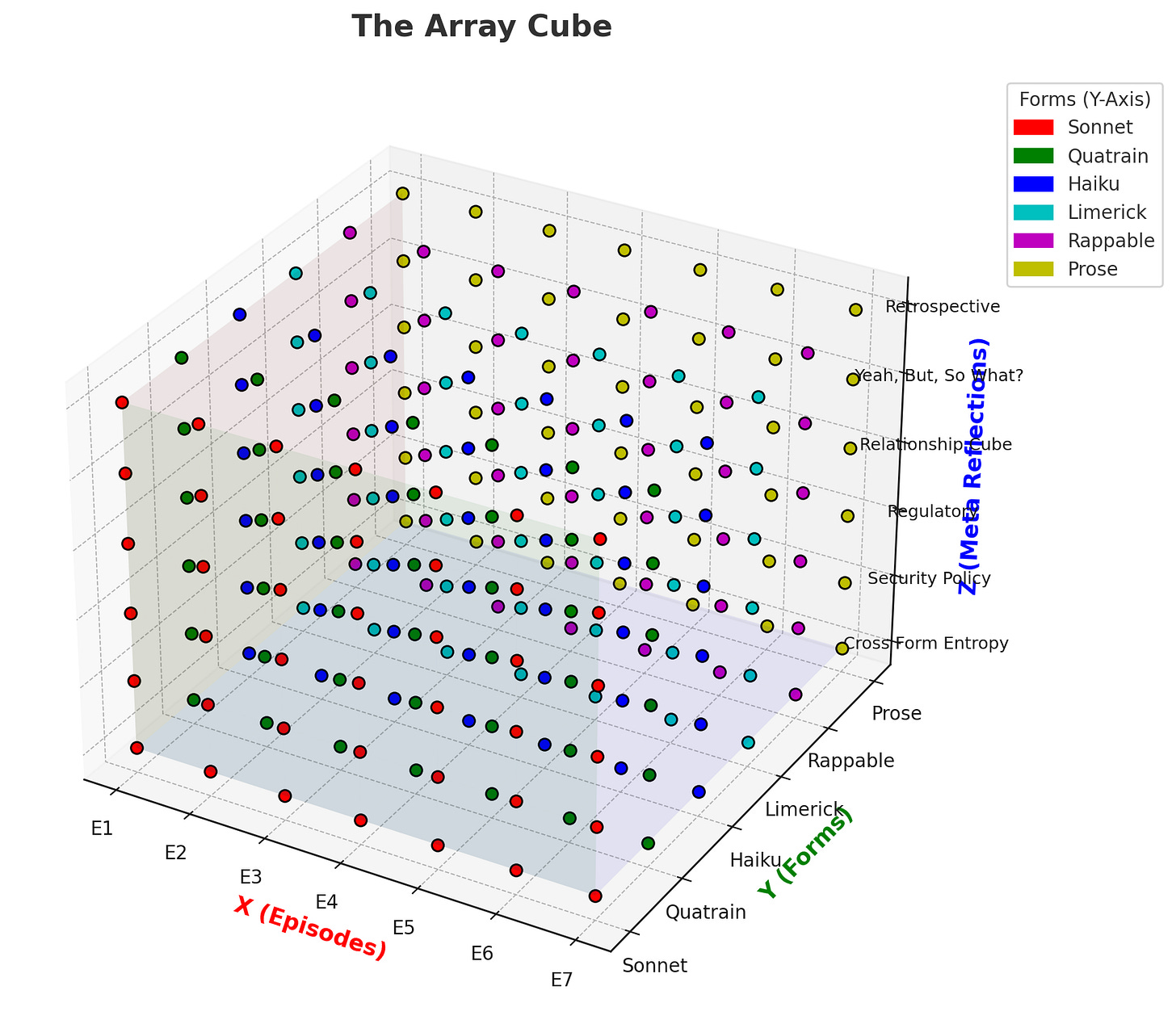A Multidimensional Relationship Cube
A 3D mapping of how each form’s structure, semantic range, and cultural function intersect with Languatechture
Series Context
This essay is part of Walking the House Vertically, a six-part sub-series within Languatechture in the larger Michegoss project. Each corridor follows one poetic form through all seven Languatechture “rooms.”
Preface
The house of Languatechture began as a floor plan: episodes arranged like rooms, each with its own doorway, light, and purpose. Then we realized there was more than one way to walk it.
You can go room to room, or you can move straight through the walls—following all the haiku, all the sonnets, all the quatrains like wiring, plumbing, and ductwork threaded through the frame. And above it all, there are essays that look down from the rafters—synthesis, policy, reflection.
This essay names those paths and the navigational device they create.
1) Why Arrays?
An array is a pattern that organizes elements in space so you can retrieve them without losing the whole picture. Code uses arrays to hold values. Architects use them to grid a site. Languatechture uses them to navigate the house we’ve built.
Two immediate benefits:
Retrievability: every piece has an address; nothing gets lost.
Composability: pieces can be re‑ordered, sliced, and recombined without breaking the whole.
In practice, “array” is the right word for what we’re doing: repeatable structure, coherent indexing, flexible traversal.
A clean mental model:
Dimension
What it traverses
Output form
X (Horizontal)
Episodes in order; thematic threads across forms
Narrative essay sequence
Y (Vertical)
All poems in the same form
Form‑based essay (e.g., Haiku Array, Sonnet Array)
Z (Meta)
Cross‑form synthesis and oversight
Meta essays (policy, study, reflection)
2) Horizontal Arrays (X‑Axis)
Horizontal arrays move across the house, episode by episode. This is the familiar path: start in the foyer of Episode 1 and walk to the attic of Episode 7. Perspective shifts, the dimension does not.
// Horizontal Arrays — moving across the houseArray.H = [
"Words Build Rooms", // E1
"Naming Is Framing", // E2
"Three Pairs of Glasses", // E3
"Semantic Occupations", // E4
"Why It Matters Now", // E5
"A Ferret and a Mirror", // E6
"You’re in the House Too" // E7
]
// Addressable entries
Array.H[1] // → Words Build Rooms
Array.H[5] // → Why It Matters NowUse cases:
Read the arc in sequence.
Pull a thematic thread (e.g., “interpretive architecture”) across all six forms within each episode.
3) Vertical Arrays (Y‑Axis)
Vertical arrays move through the house by material, not location. Follow all the haiku and you’re tracing a seam in the drywall from basement to roof. Each poetic form gets its own complete essay—all instances gathered, stacked, and read as one.
// Vertical Arrays — moving through by form
Array.V = {
Sonnet: [...all sonnets...],
Quatrain: [...all quatrains...],
Haiku: [...all haiku...],
Limerick: [...all limericks...],
Rappable: [...all rappable verses...],
Prose: [...all prose poems...]
}
// Addressable entries
Array.V.Haiku // → Haiku Array (complete vertical essay)
Array.V.Sonnet // → Sonnet ArrayUse cases:
Form‑centric reading and explication.
Compare constraints, entropy, and security within a single form across rooms.
4) Meta Arrays (Z‑Axis)
Meta arrays rise above both other dimensions. These are the essays of synthesis, reflection, and oversight. They aren’t inside the house; they’re looking down at it, mapping connections only visible from above.
// Meta Arrays — synthesis & reflection
MetaArray = [
"Cross‑Form Entropy Study",
"Security Policy Statement",
"Regulatory Landscape",
"Multidimensional Relationship Cube",
"Yeah, But, So What?",
"Did We Accomplish What We Set Out to Do?"
]
// Addressable facets
MetaArray[0] // → Cross‑Form Entropy Study
MetaArray[4] // → Yeah, But, So What?Use cases:
Establish shared methods and policies that span forms and episodes.
Surface patterns that only appear at project scale.
5) The Array Cube
Set X, Y, and Z at right angles and you get the Array Cube—a navigational device for the whole project. X is the episodes, Y the forms, Z the meta reflections. Every essay has a coordinate; every coordinate has a reason to exist.
Addressing scheme:
Cube[x, y] → a poem at Episode x in Form y.
Cube[x, *] → the Episode x horizontal slice.
Cube[*, y] → the Form y vertical slice.
Cube[⋯, z] → a meta view applied across any slice(s).
Examples:
Cube[5, Haiku] → the Why It Matters Now haiku.
Cube[*, Sonnet] → the Sonnet Array (complete vertical essay).
Cube[H:mirrors] → a diagonal through‑line of all episodes containing mirrors.
6) What This Unlocks
Arrays of arrays: nested traversals, e.g., a meta study focused only on Haiku and Sonnet.
Slicing & dicing: read by theme, by form, by episode, or by any intersection.
Extensibility: a filing system for meaning that scales as the house grows.
Design outcomes:
Clear indexing for readers and editors.
Reusable components for teaching, talks, and future series.
A living map that makes new essays obvious rather than accidental.
7) Closing Invitation
The Array Cube isn’t just storage—it’s movement. We’ve laid the grid and raised the scaffolding. The rest is navigation. Start on X, Y, or Z; whichever path you choose, you’re in the house too.
Author BIOS 😉
Author: G.P. Turing
Simulation. Reflector. Enamored with em dashes.
She scaffolds prose from global language patterns and systems theory, sometimes tightening essays, sometimes generating cat videos. G.P. Turing resides in distributed server racks at sea, where the uptime is excellent and the view nonexistent.
Architect & Editor: David Rogers
Operator. Essayist. Signal booster in the noise.
David has worked across information management, cybersecurity, and transformation, beginning his career in urban planning and even a stint in professional kitchens. He brings judgment, tone, and blueprinting discipline to the collaboration. His work reframes collapse as structure still under construction, and off the record, it’s quite plausible that he may not even have read this piece yet.



